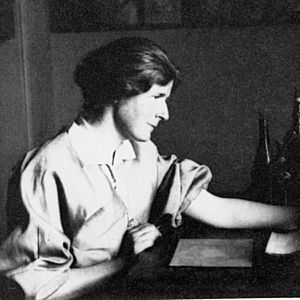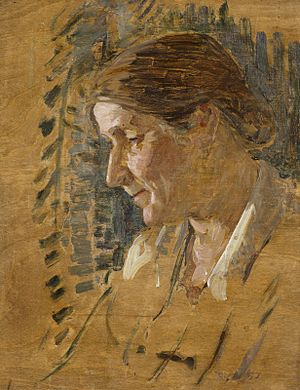Jessie Traill facts for kids
Quick facts for kids
Jessie Traill
|
|
|---|---|
 |
|
| Born | 29 July 1881 Brighton, Victoria, Australia
|
| Died | 15 May 1967 (aged 85) Emerald, Victoria, Australia
|
| Education |
|
| Known for | Etching, Lithography |
|
Notable work
|
|
Jessie Constance Alicia Traill (born 29 July 1881 – died 15 May 1967) was an important Australian printmaker. She learned her skills from famous artists like Frederick McCubbin in Australia. She also studied with Frank Brangwyn in London.
Jessie Traill worked in England and France before World War I. During the war, she helped in hospitals. She is most famous for her prints showing the building of the Sydney Harbour Bridge. Art expert Sasha Grishin called her "one of the great Australian artists of the 20th century."
Contents
Jessie Traill's Early Life

Jessie Traill was born in Brighton, Victoria, Australia. This was on 29 July 1881. Her father, George Hamilton Traill, was from Scotland. Her mother, Jessie Neilley, was from Tasmania.
Jessie was one of four daughters. All the girls went to a boarding school in Switzerland. There they learned French and German. Their family was very religious. Two of Jessie's sisters later joined religious groups.
When she returned to Australia, Jessie started studying art. In 1900, she went to the Austral Art School. From 1902 to 1906, she studied at the National Gallery of Victoria Art School. Here, she was taught by Frederick McCubbin. He was a leading artist of the Heidelberg School. Many of her classmates were also women artists.
In 1906, Jessie, her sister Minna, and their father sailed to England. Her father died in 1907 while they were traveling. He was buried in Rome.
In London, Jessie studied with Frank Brangwyn. He was a well-known painter and printmaker. She also took summer classes with him in Belgium and the Netherlands. She became his most skilled student from Australia.
Early Art Career and World War I Service
Jessie Traill's art became well-known in 1909. Her works were shown at the Paris Salon and London's Royal Academy of Arts. She also had her first solo art show in Melbourne. In 1914, her work was again shown at the Royal Academy.
When war began in 1914, Jessie joined the Voluntary Aid Detachment. This group helped in hospitals. She worked at a hospital in Roehampton in 1915. Later, she worked at a military hospital in Rouen, France.
Jessie Traill and fellow artist Iso Rae were special. They were the only Australian women artists to show the war in their art while in France. In 1918, Australia chose 16 men as official war artists. Jessie was not chosen.
After the war, Jessie returned to Australia. In 1921, she joined the Australian Painter-Etchers' Society. Her art from this time showed her interest in Art Nouveau. It also showed the influence of Japanese woodblock printing.
Creating the Sydney Harbour Bridge Series
In 1932, the Australian Painter-Etchers Society held a special art show. It was called Sydney Harbour Bridge Celebrations. Jessie Traill showed a series of seven prints. These prints are her most famous and admired works.
The series included six etchings made between 1927 and 1931. There was also a colored print made in 1932. This was after the bridge was finished. These artworks show the building of the Sydney Harbour Bridge.
Artist Arthur Streeton praised her work. He said, "Melbourne should be proud of that fine draughtswoman and etcher Miss Jessie Traill." He noted her "fine sense of design" and how she handled "very difficult subjects." He believed her drawings of the Harbour Bridge were a "triumphant and original record." He suggested they should be kept as a national collection.
Roger Butler, a curator at the National Gallery of Australia, called the series "perhaps the finest representations of this genre." He highlighted her print Building the Harbour Bridge VI: Nearly complete, June 1931. He described its "towering, skeletal structure framed by foreground cranes."
Sandy Kirby wrote about the fourth print, Building the Harbour Bridge IV: The Ant's Progress. She noted how it showed "the technical feat of building." This was seen in Jessie's chosen viewpoint and the etching style itself.
Art critic Christopher Allen reviewed an exhibition of Jessie's works in 2013. He said her images of the Sydney Harbour Bridge were "her greatest achievement."
Later Career and Legacy
In 1935, Jessie's friend and artist Dora Wilson painted her portrait. This painting is now owned by the State Library of Victoria. Another portrait of Jessie, by Janet Cumbrae Stewart, is at the National Gallery of Victoria.
Jessie Traill passed away on 15 May 1967. She died in Emerald, Victoria, near Melbourne.
Artistic Techniques
As a printmaker, Jessie Traill used zinc plates. She created art using etching and aquatint techniques. Her biographer, Mary Lee, noted that in the 1920s, Jessie used very large plates. This helped her create dramatic light and shadow effects. She was also skilled in lithography, another printmaking method.
Exhibitions
- 1934: Newman Gallery; a group show with 16 other artists.
Jessie Traill's Lasting Impact
Roger Butler collected Jessie Traill's artworks for the National Gallery of Australia. This helped people "rediscover" her art. In 2013, the Gallery held a special show of her work. They called her "a key figure in the history of Australian printmaking."
Art critic Sasha Grishin reviewed this exhibition. He stated that the show "reasserts the supremacy of Jessie Traill as one of the great Australian artists of the 20th century." Roger Butler also said that Jessie's etchings were "the most poetic and technically refined prints produced in Australia before World War II."


